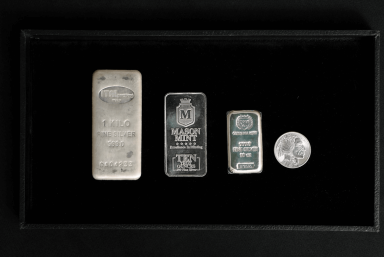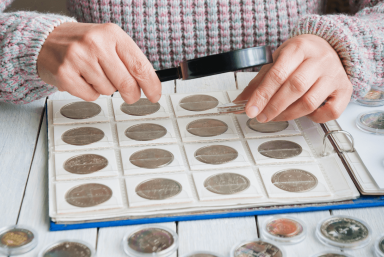
Coin grading is the professional evaluation of a coin’s condition that directly impacts its value in the numismatic marketplace. Coins are graded based on a set of criteria that evaluate factors such as wear, luster, surface preservation, and overall appeal. The grading scale (Sheldon Scale) ranges from the lowest possible grade of Poor-1 (PO1) to the best possible grade of Mint State 70 (MS70), with numerous intermediate grades reflecting varying degrees of wear and preservation.
What are the benefits of having a coin professionally graded?
There are many benefits to having your coins professionally graded. Professional grading services authenticate coins, ensuring they are genuine and not counterfeit. This adds a layer of trust and confidence for buyers and sellers.
Professional graders follow strict protocols, reducing subjectivity and bias in the grading process.
Coins are encapsulated in tamper-evident, protective holders that shield them from physical damage, environmental factors, and potential mishandling.
Graded coins are more liquid and easier to sell, as buyers have confidence in the certified grade and authenticity. For both investors and collectors, professionally graded coins offer a reliable way to assess the potential value and future appreciation of their investments.
What are the most reputable coin grading services?
The most reputable coin grading services are the Professional Coin Grading Service (PCGS) and Numismatic Guaranty Corporation (NGC). These coin grading services adhere to rigorous grading standards, employ experienced numismatists, and utilize advanced technologies to ensure the accuracy, consistency, and integrity of their certification process. Collectors and investors can confidently rely on coins certified by these reputable grading services for their authenticity, quality, and market value.
Be cautious of less reputable grading companies that are not widely recognized within the numismatic community and may lack the expertise and standards necessary for accurate grading. Companies that frequently assign grades that are significantly higher than what would be assigned by industry leaders are often suspect. Coins graded by these companies often sell for less than similar coins graded by reputable companies. Companies that do not provide clear information about their grading process and standards should be approached with caution. Check forums, reviews, and expert opinions for any red flags about specific grading companies.
What is the process for grading a coin?
Using the right tools and handling coins properly is essential to accurately grading a coin. A magnifier, or a loupe, is used to examine the fine details of a coin for imperfections. A 5x magnifier is recommended for this purpose. A proper light source must be used to accurately assess luster and surface marks. Be sure to always handle coins by the edges to avoid adding fingerprints or oils from your skin.
In most cases, cleaning coins is not recommended, especially if they have any numismatic value. Cleaning can significantly reduce a coin's value by altering its surface and removing the natural patina that collectors often find desirable.
What are the key factors when grading a coin?
1. Wear:
Wear is one of the primary factors affecting a coin's grade. As coins circulate, they gradually lose detail due to friction and contact with other surfaces. Understanding the progression of wear from barely noticeable to major loss of details is essential for accurate grading.
2. Surface Preservation:
The preservation of a coin's surfaces, including the absence of scratches, dents, or discoloration, significantly impacts its grade. Coins with pristine surfaces command higher grades and values.
3. Strike Quality:
The quality of a coin's strike, including the sharpness of its details and the completeness of design elements, is another critical aspect of grading. Well-struck coins with crisp details typically receive higher grades.
4. Luster:
Luster refers to the reflective quality of a coin's surfaces, resulting from the way light interacts with its metal. Coins with vibrant luster are highly desirable and often receive higher grades.
5. Eye Appeal:
Beyond technical considerations, eye appeal encompasses subjective factors such as color, toning, and overall aesthetic appeal. Coins with exceptional eye appeal can command premium prices despite minor imperfections.
How much does it cost to get coins professionally graded?
The cost of getting coins graded varies depending on factors such as the grading service, the number of coins being submitted, the service level chosen, and any additional services requested. A basic grading fee covers the cost of evaluating and encapsulating the coin in a holder. A service level fee may apply depending on the value of the coin and desired turnaround time. Additional services such as variety attribution, re-holdering, conservation, or photography may be selected for an extra charge. These services can enhance the coin's presentation or provide additional information about its characteristics. The individual submitting coins for grading is often responsible to cover the cost of shipping both to and from the grading service.
Overall, the cost of getting coins graded can start at $30-40 up to several hundred dollars per coin, depending on the grading service, service level chosen, and any additional services requested. It's essential to consider these factors and evaluate the potential benefits of professional grading based on the coin's value, rarity, and marketability.
How long does it take to grade a coin?
Generally, grading services offer different turnaround times ranging from express services, which can take between a few days to a couple of weeks, or standard services which may take several weeks up to months.
How do I submit coins to be graded?
Select a reputable coin grading service such as the Professional Coin Grading Service (PCGS) or Numismatic Guaranty Corporation (NGC).
Some grading services require you to become a member to submit coins directly. Membership often includes benefits like discounts and submission privileges. If you prefer not to join, you can submit your coins through an authorized coin dealer, who can handle the submission on your behalf.
Prepare your coins for submission by completing the submission form and protecting your coins for shipment in plastic mylar flips. Be sure to include the submission form and payment for grading services in your shipment.
Mail coins to the selected grading company using a mail service that provides tracking information and insurance to protect your coins.
Be sure to check the grading service’s website for their specific policies and procedures for submitting coins for grading.
The coin grading service website will provide confirmation when your coins have been received and during all steps of the grading process. When grading is completed, the grading service will provide details about when you can expect your coins to be returned to you in the mail.
Learn more about coins and coin grading
Coin grading is vital for accurately assessing and valuing coins. It offers authentication, protection, and increased marketability, making coins more appealing to buyers and sellers. Understanding and using professional coin grading can greatly benefit collectors and investors' numismatic endeavors. Always opt for trusted grading services and follow submission guidelines to ensure your coins are properly evaluated and protected. For more information about coin buying and selling, contact Edelman’s today!





